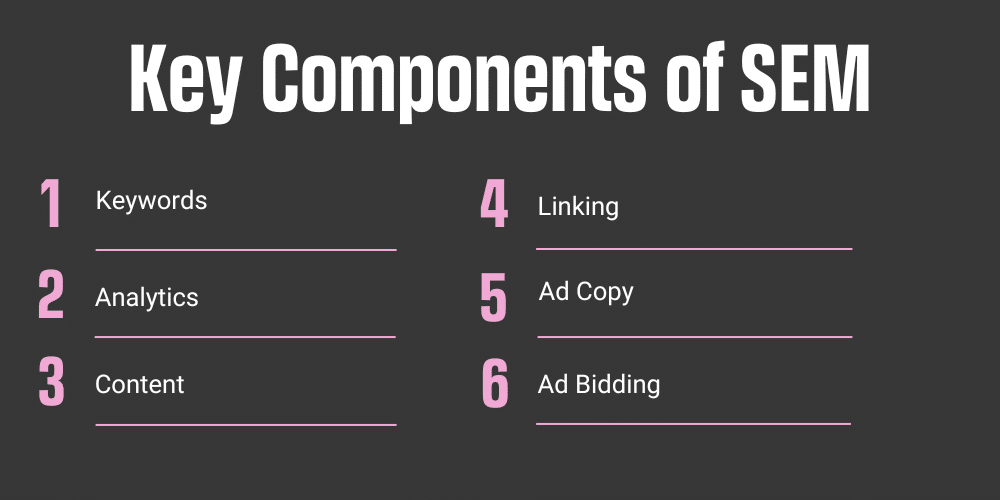
-
Georgia Smith
- 4 Min Read
- Blog, Search Engine Marketing
Exploring the Key Components of SEM
With so many areas of digital marketing, knowing which components fall into which category is always challenging. So, let’s run through 6 key components of SEM and clear up any confusion.
Why SEM?
SEM or search engine marketing covers marketing actions and channels that boost a business’s visibility in search engines.
So, if you have a website and want your ideal customers to find you before your competitors, you need SEM. Simple.
You can break down SEM into two key channels. They are often referred to as the organic and paid sides of SEM. These channels are SEO (Search engine optimisation) and PPC (Pay-per-click) Advertising.
To boost your search engine marketing, check out our services and see how our team of specialists can help you grow online.
6 Key Components of SEM
Some key components of SEM are covered in both channels. Other components are specific to each.
- Keywords
Keywords are the backbone of any SEM campaign, whether it’s paid or organic. They may hold the same level of importance, but the metrics you look at differ ever so slightly.
Organic – You should look at your organic keywords’ volume, intent, and keyword difficulty. This way, you know how many people are searching for that keyword. You also know what they’re looking for and how hard it will be for your content to rank.
Paid – Volume is still vital, as is the intent for your paid search campaigns. The difference comes with cost per click (CPC) and competitive density. This gives you the average cost advertisers pay per click on ads for that keyword. And the competition from other advertisers on that keyword within PCC campaigns.
- Analytics
It’s no secret that analytics are one of the most crucial components of SEM campaigns. But knowing what to look for per campaign is the hard part.
For your paid campaigns, you’ll often find the analytics within the ad platforms themselves. They often cover cost-per-click, cost-per-acquisition, impressions, click-through-rate and more.
For your organic content, you must look within your website using platforms like Google Analytics. You can find metrics like bounce rate, user time on site, organic traffic, and conversions from organic search.
- Content
Content focuses on the organic/SEO side of SEM. Writing content focused on what your audience wants with SEO in mind is crucial in today’s search landscape.
At one point, solely writing content to rank would secure the number-one position on search engine results. However, after the introduction of the helpful content update from Google, this is no longer the case.
So, when you write your next blog piece for your website, think of your customers. Think of what they’re looking for and factor in best practices to boost your SEO to reach them.
- Linking
Linking can be split into two different tactics. This includes internal linking and backlinking, both of which surround your organic content and website.
Internal linking refers to pages within your website pointing at one another. This demonstrates to search engines a relationship between two web pages. It helps them discover your content as it crawls through these pages.
Backlinks – These are links back to your site coming from other sites. When it comes to search engines and backlinks, it’s a case of quality over quantity. Few high-quality links will benefit your site more than plenty of spammy, low-quality links.
- Ad Copy
Ad copy is exactly what is says on the tine. It is the wording and messaging that you pair with your ads.
Whichever ad platform you use, whether it’s Google Ads, Microsoft ads etc., you must follow some basic key practices. You should be aware of how many ad variants you are allowed. For example, the Google ads platform provides up to 15 headlines and descriptions. Make sure you’re using these headlines to their full potential.
Your ad copy should be specific to your campaign and the keywords you’re focusing on. The more specific, the better. Conduct audience research and determine their behavioural traits, use this to create ads that appeal to your target audience.
Check out our blog post, ‘How to write PPC Ads that get clicks,’ to boost your ad copy.
- Ad Bidding
When a user makes a search, all of the ads available for that search term head into an auction. From there, the search engine considers different factors to determine which ads should appear.
Ad bidding and auctions differ from platform to platform but generally rely on your ad quality and bid amount.
Your ad quality or quality score is an estimate from ad platforms about user experience when users see your search ads.
It includes a range of factors: relevant ad text, how likely people are to click your ad and the quality of the experience on your landing page.
The better your ad quality is from the offset, the better your ads will likely perform. This includes securing better ad positions and avoiding wasted ad spend.
When it comes to bidding, platforms often have an automated bidding option set up. This is usually titled “Maximise Clicks” or “Maximum Delivery”. These are hands-off approaches that you can set running and not really think about again. However, they are known to be less effective and results-driven.
The recommended method is setting a maximum CPC (Cost Per Click). This is pretty much exactly as it sounds: you get to set the maximum amount you’ll willingly pay for a click on ads within an ad group, specific keywords or placements.
Whilst every ad platform is different, they’re often transparent with how they run their ad auctions. The more prominent platforms like Google Ads and Microsoft Ads have Ads Help Sites to answer any questions you have, from bidding to copy to creative.
Whether you need organic or paid search engine marketing at ROAR, we have the solution for your business. Check out our services to accelerate your business today!





